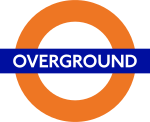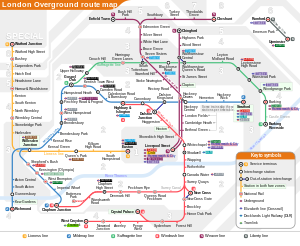London Overground
 |
|||

A London Overground class 378 train at Canonbury
|
|||
| Overview | |||
|---|---|---|---|
| Owner | Transport for London (TfL) | ||
| Locale | Greater London; Hertfordshire, UK | ||
| Transit type | Suburban rail & Commuter rail | ||
| Number of lines | 9 | ||
| Number of stations | 112 (10 operated) | ||
| Annual ridership | 160 million | ||
| Website | www |
||
| Operation | |||
| Began operation | 11 November 2007 | ||
| Operator(s) | Arriva Rail London 13 November 2016-2023 | ||
| Reporting marks | LO (National Rail) | ||
| Technical | |||
| System length | 167 km (103.8 mi) | ||
| Track gauge | 1,435 mm (4 ft 8½ in) Standard | ||
| Electrification | 25 kV AC overhead lines 750 V DC third rail |
||
|
|||
The London Overground (also known as the Overground) is a suburban rail network in the United Kingdom. Established in 2007, it serves a large part of Greater London and parts of Hertfordshire, with 112 stations on several routes. The network forms part of the National Rail network, but under the franchise control and branding of Transport for London (TfL). Operation has been franchised to Arriva Rail London since 13 November 2016.
The Overground has been assigned the colour orange as a mode specific colour by Transport for London. This colour is used in the Overground version of the TfL roundel, for the representation of Overground routes on the tube map, in train interiors and elsewhere.
Rail services in Great Britain are mostly run under franchises operated by private train operating companies, marketed together as National Rail.
The concept of developing a network of orbital services around London goes back to the independently produced Ringrail proposals in the early 1970s. Some of these were evaluated in the London Rail Study of 1974 (The Barren Report) and Barren suggested consideration of a North London Network of orbital services, based on a later suggestion by the Ringrail Group, which involved using many existing rail routes, rather than new construction suggested in earlier drafts of the Ringrail Plan.
The proposal from Barren was for several overlapping services mainly using the North London Line, generally at 20-minute intervals. The suggested routes followed the original North London Line service from Broad Street to Richmond, and new services from Barking to Clapham Junction, and a third service from Ealing Broadway to North Woolwich. However, the continuing antipathy to the railways from the third Wilson government, along with the lack of interest in minor local train services by British Railways' management, meant that few of these initiatives were carried forward.
...
Wikipedia

